- 1Engaged in the Study of the Sinicization of Marxism, Administrative Management Teaching and Research Section, Party School of Jiangmen Municipal Committee of the Communist Party of China, Jiangmen, China
- 2Engaged in Open Economic Strategy and Political Economics Research, School of Marxism, Sun Yat-sen University, Guangzhou, China
- 3Institute of Enterprises Research, Sun Yat-Sen University, Guangzhou, China
- 4School of Economics and Trade, Guangdong University of Foreign Studies, Guangzhou, China
Based on the perspective of political economics analysis, this article conducts research on the national new energy strategy as the economic situation changes differently from the past. Under the socialist market economy system with Chinese characteristics, the new energy strategy is not only an inevitable choice for China as a responsible major country, but also a key measure to promoting high-quality economic development. Through the analysis of the main dilemmas faced by China’s implementation of new energy strategy, this article proposes to design policies in terms of core technology research, innovative industry financing, cultivating professional talents, and continuous expansion of opening up, to originate a high-quality development path for China.
Chapter 1. National Political Economics of New Energy Strategy
On September 22, 2020, Chinese President Xi Jinping made a statement at the general debate of the 75th session of the United Nations General Assembly, stressed that: “China will scale up its Intended Nationally Determined Contributions by adopting more vigorous policies and measures. We aim to have CO2 emissions peak before 2030 and achieve carbon neutrality before 2060.”1 This is a major strategic decision made by China based on the internal requirements of promoting a shared future for building a human community and achieving sustainable development. Afterwards, at the Third Paris Peace Forum, the Twelfth Meeting of the Leaders of the BRICS Countries, the Leaders’ Side Event on Safeguarding Planet of G20 Riyadh Summit, and the World Economic Forum Virtual Event of the Davos Agenda, General Secretary Xi has mentioned the goal of achieving carbon peak and carbon neutralization many times, reflecting China’s determination to actively respond to climate change.
As showed in Figure 1, since the 21st century, global carbon emissions have increased rapidly. From 2000 to 2019, the emissions of carbon dioxide increased by 40%. According to the data from the “World Energy Statistical Yearbook (70th Edition)” released by BP, global carbon emissions have continued to grow since 2013. In 2019, this indicator even reached 34.36 billion tons, hitting a historical high. As the world’s largest developing country, China should shoulder the responsibility of energy saving and emission reduction in the world economic development, actively respond to climate change, and look forward to global cooperation.
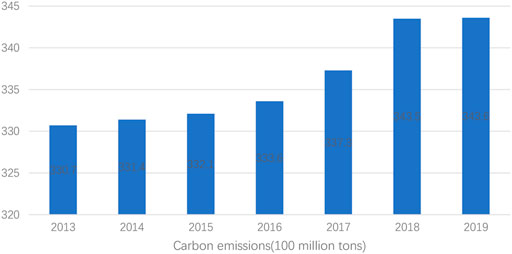
FIGURE 1. Trends in global carbon emissions (2013–2019). Data Sources: BP “World Energy Statistical Yearbook (70th Edition)”.
At the same time, China’s 14th Five-Year Plan listed carbon peaking and carbon neutrality as important tasks for China’s economic and social development in the next 5 years. 2021–2025 is a critical period and window period for carbon peaking, the “14th Five-Year Plan (2021–2025) for National Economic and Social Development and the Long-Range Objectives Through the Year 2035” clearly states that China should implement the nationally determined contribution target for climate change in 2030 with a more active attitude, and specifically formulate action plans for peak carbon emissions to reduce carbon emission intensity, support qualified localities and industries to take the lead in reaching the peak of carbon emissions, improve the carbon sink capacity of the ecosystem, and strive to achieve carbon neutrality by 2060. To this end, the “14th Five-Year Plan” also noted that China should focus on the development of new energy and other strategic emerging industries, promote the application of core technologies, and cultivate new growth momentum for industrial development.
New energy industry is also an important engine to promote the establishment of a “dual circulation” development pattern. The main characteristics of this pattern is that it has two circulations, the domestic economic cycle plays a leading role and the domestic and international economic cycles mutually encourage each other. From the perspective of internal circulation, China’s economy is gradually transforming from high-speed development to high-quality development. The transformation and upgrading of the energy structure will help ensure domestic energy security (Andrew, 2010), and deepen supply-side reforms, and create a dynamic balance of demand-driven supply and supply-creating demand. From the perspective of external circulation, Europe is currently China’s second largest trading partner, the most important source of imports and the second largest export destination. The upgrading process of the European new energy industry is in line with China’s improvement of the strategic position of the new energy industry, which will help the two parties become important strategic partners, promote the strengthening of the chain of China’s new energy industry, expand the opening up against the background of the external economic cycle, and form a strong attraction to global resource elements.
Under the socialist market economy system with Chinese characteristics, it is not only a national strategy to promote the development of the new energy industry, but also an important starting point for accelerating high-speed and high-quality economic development. The growth of the new energy industry helps to alleviate the impact on China’s healthy operation of the economy caused by the limited traditional energy reserves and large price fluctuations; at the same time, in order to have CO2 emissions peak before 2030 and achieve carbon neutrality before 2060, form new international competitive advantages and create new economic growth points, China should continue to stimulate the development of a low-carbon economy and place new energy industries in an important strategic position for economic growth (Xiliang et al., 2016). Finally, new energy industries can help moderate the over-reliance on petroleum and coal for the advancement of various industries for a very long time, and rationalize the industrial structure. Transformation and upgrading will help areas that are currently relatively underdeveloped to adapt to local conditions, give full play to the advantages of solar and wind energy, form economies of scale, and drive regional economic development.
Chapter 2. New Energy Strategy Boosts High-Quality Economic Development
Respond to the Energy Crisis Actively
There are three aspects of main problems exists in China’s energy currently.
Firstly, China’s energy is relatively scarce, and the reserves of traditional energy are limited, which cause the serious insufficiency per capita. Based on the situation, China is facing a severe energy crisis and challenge. If new energy industry can’t be developed and utilized as soon as possible, China’s economic structure and development will be greatly affected.
Secondly, China is provided with unbalanced energy structure. Most of the energy used in China is coal, which create a condition that overall utilization of traditional energy is inefficient, making it difficult to meet the needs of high-quality economic development in the new era (Xiangzhong and Yue, 2019).
Figure 2 shows the proportion of coal, crude oil and natural gas consumption in total energy consumption of China from 2003 to 2018. As the most important energy source for China’s economic development, coal consumption accounts for more than 50% of total energy consumption in the past 16 years, in particular years, 2005 and 2006, this proportion was as high as 72.4%. In recent years, with the proposing of requirements about developing high-quality economic, China’s dependence on coal energy has been reduced, and the proportion of coal consumption in total energy consumption fell below 60% for the first time in 2018. Corresponding to the reduction is the increase in the proportion of natural gas energy consumption, but this increase is lower than the decline in coal consumption, which indicate that China’s consumption of other alternative energy sources is also increasing. On the whole, although the proportion of coal consumption is declining, China’s economic development is still restricted by the heavy dependence on coal energy. It means that China needs to implement a new energy strategy to promote high-quality economic development urgently.
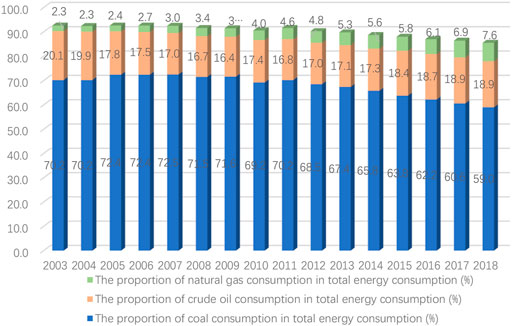
FIGURE 2. The percentage of China’s energy consumption (2003–2018). Data Sources: China Statistical Yearbook 2004–2019.
Thirdly, China lacks the dominance over energy prices. As the second largest oil consumer in the world, China does not have a dominant advantage in oil trading and pricing. It will not only bring a large unknown risk to the country, but also transmit the influence to the domestic bulk market and related energy industries through the price linkage mechanism, affecting the speed of the development of various domestic industries and hinder the growth of GDP.
It can be seen from Figure 2 that the proportion of China’s crude oil consumption to total energy consumption remained basically unchanged from 2003 to 2018, and has maintained at about 20%. Combined with the total oil consumption shown in Figure 3, the consumption of crude oil in China is increasing year by year, which shows that with the development of economy, China’s energy demand is also expanding. However, reviewing the quantity of import and export of China’s petroleum resources from 2003 to 2018, this paper found out that about 50% of China’s crude oil consumption needs to be obtained from abroad. These data reveal the fact that China does not have a dominant advantage in oil trade and pricing, and the domestic economic development could be easily affected by fluctuations in international oil prices.
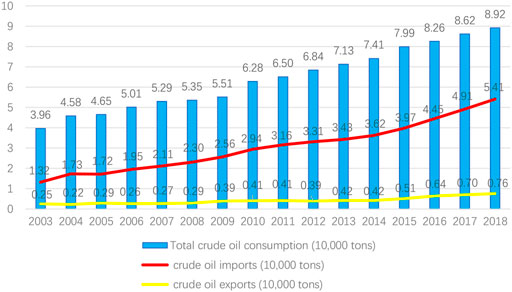
FIGURE 3. China’s crude oil consumption, import and export data (2003–2018). Data Sources:China Statistical Yearbook 2004–2019.
The development of new energy is an effective way to solve the problem of energy shortages and restriction. China needs to resolutely promote reforms in the energy sector, accelerate the establishment of systems and mechanisms which is conducive to the development of energy science and technology, improve the energy development environment, and advance changes in energy production and utilization methods (Ying, 2021). The development of new energy can play an important role in adjusting energy structure, reducing greenhouse gas emissions, and promoting the development of strategic emerging industries. New energy resources are rich in reserves, have renewable characteristics, and can be used permanently by humankinds, besides, new energy resources do not contain carbon or have a small carbon content, which make them more environmentally friendly. Therefore, the development of new energy industries can not only open up different energy supply channels and effectively increase the purveyance of energy, but also reduce environmental pollution, promoting economic green and low-carbon development (Qiao and Hongtao, 2021). At the same time, the development of new energy will help reduce the proportion of fossil energy in China’s energy demand, solve the problem of China’s economic development’s heavy dependence on imported energy, relieve energy pressure, diversify the energy structure, reduce the risks brought by the weakening of the inherent energy structure, ensure national energy security, and fundamentally solve China’s energy problems.
Promote the Development of Low-Carbon Economy
Low-carbon economy is conducive to enhancing core competitiveness. The essence of low-carbon economy is an economic system of efficient use of energy, development of clean energy, and pursuit of green GDP. Its core characteristics lie in the innovation of energy technology and emission reduction technology, the innovation of industrial structure and systems, and the fundamental transformation of the concept of human survival and development. A low-carbon economy is an inevitable choice to achieve economic development and protect resources and the environment. The development of low-carbon economy and the smooth advancement of energy conservation and emission reduction are inseparable from technical support (Yan and Lian, 2013). With the adjustment of energy supply and consumption structure, the intensity of China’s demand for green, low-carbon, smart energy and new technologies will continue to grow.
Compared with developed countries, China has a certain gap in some advanced core technologies, carbon storage technologies and other key new energy technologies such as energy saving and emission reduction technologies. However, in other areas, such as solar and wind energy development and commercial operations, China is in a leading position in the world. At the same time, China’s relatively abundant labor force makes it more cost-effective to develop a low-carbon economy. With the help of the development in the fields mentioned above, China will form a new competitive advantage in international competition, thereby changing the low-end image of the “world factory”, starting to move towards the production of high value-added industries, and enhancing home country’s core competitiveness.
In order to promote the development of the low-carbon economy, China has continuously increased its R&D investment in mining and washing of coal, extraction of petroleum and natural gas industries in recent years. As shown in Figure 4, with the exception of slight declines in some years, the overall upward trend in R&D expenditures for the two types of industries is obvious. This fact indicate that China is increasing investment in key new energy technologies such as advanced core technologies and carbon storage technologies, which shows China’s determination to develop a low-carbon economy and implement a new energy strategy.
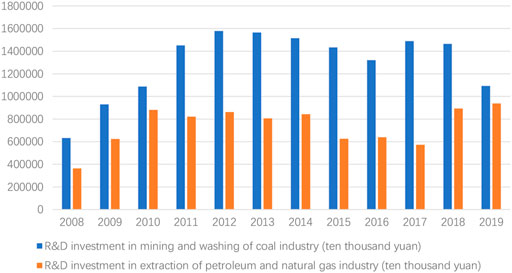
FIGURE 4. R&D investment in mining and washing of coal, extraction of petroleum and natural gas industries (2008–2019). Data Sources: China Statistical Yearbook 2009–2020.
A low-carbon economy can help to realize the leapfrog development of China’s economy. In the process of development, the low-carbon economy can continuously improve its own institutional framework, related policies and measures to promote the research and development, practice of energy-efficient science and technology, energy-saving and renewable energy technologies, and greenhouse gas emission reduction technologies. Moreover, the development of a low-carbon economy is bound to change the past extensive economic growth mode, optimize and upgrade the industrial structure and economic structure, avoid the influence of the “lock-in effect”, and promote the development of related industries such as the new energy and the promotion and application of its products (Ming and Xiaowen, 2015). In addition, the rapid development of low-carbon technology in developed countries will push low-carbon products to the market, stimulate the progress of China’s low-carbon technology, and further optimize China’s economic development structure (Jing et al., 2016). The development of a large number of new energy projects in China will create more jobs, promote green employment, reduce China’s employment pressure, ease social contradictions, industrial structure transformation and economic development model adjustments will be promoted, and China’s economic development will achieve leapfrog development.
The rapid development of a low-carbon economy in the international community will prompt the establishment of new rules for the world’s economic pattern. It is an urgent requirement and strategy for achieving scientific, harmonious, green and low-cost development to develop a low-carbon economy, build a low-carbon society, and encourage the fundamental transformation of China’s economic development from a high-carbon energy economy to a low-carbon and carbon-free energy economy (Caineng, 2021). At present, although China has late-comer advantages in the aspects of globalization, institutional arrangements, industrial structure, and technological revolution, it still also be constrained by the dominant international rules of developed countries. In order to Break through the constraints, China should develop the low-carbon economy to cooperate with developed countries in terms of new technology research and development (Zheng-Xin et al., 2017), enjoy the latest technological achievements, and get the opportunity to discuss and formulate new rules of the game, grasp the initiative of the country’s low-carbon economic development, and promote the sustained and rapid development of the country’s economy.
Contribute to the High-Quality Development of the National Economy
China’s economy has shifted from a stage of rapid growth to a brand-new level of high-quality development. Under the background of achieving carbon peaking and carbon neutrality goals, the rapid growth of the new economy represented by the new energy industry has accelerated the release of the huge potential of economic development and continued to consolidate China’s economic growth. The foundation of high-quality development has made China’s economy more solid in its green transition.
It can be seen from Figure 5 that as China’s GDP continues to increase, the value of contract deals of new energy and power saving in domestic technical markets has also increased, that is, there is a positive correlation between China’s GDP and the output value of new energy and high-efficiency energy-saving industries. In 2010, the turnover of the contract deals of new energy and power saving in domestic technical markets in China was 544,696.9 billion yuan. By 2019, it has grown to 28,135,523, achieving a growth rate of 416.54%. Therefore, in the process of China’s economic transition to high-quality development, the new energy industry is also facing the historic development opportunities, and its potential value is closely connected with China’s economy.
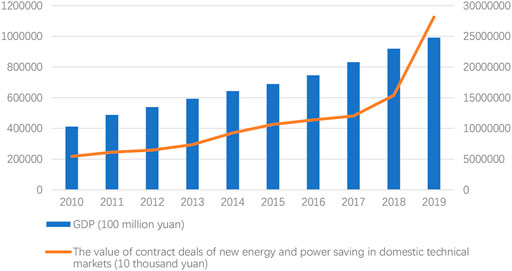
FIGURE 5. China’s GDP and the value of contract deals of new energy and power saving in domestic technical markets (2010–2019). Data Sources: China Statistical Yearbook 2011–2020.
Developing new energy industry will bring about greater economic benefits. The rise of new energy has greatly promoted the development and upgrading of China’s new energy companies, while technological research and development and manufacturing of advanced equipment require a large amount of comprehensive consumption of human and material resources, will help stimulate domestic consumption growth and provide more jobs Vacancies for the society. That is, the development of emerging industries such as new energy can add new breakthrough points and growth points to the country’s economic growth (Dingbang, 2020; Qian, 2021). At the same time, environmental pollution control is a long-term process. High cost and insignificant effect are the difficulties for countries to control environmental pollution, which have always hindered the economic development of a country, while the characteristics of renewable, pollution-free, and low emissions that new energy could be used to solve the problem of environmental pollution. Gradually, new energy will reduce the state’s investment in environmental governance, and promote economic development to a certain extent. Finally, new energy is an important guarantee for the national energy security strategy in the new era. It has a broad international market and the market-oriented development of the new energy industry will inevitably produce huge economic benefits, playing a vital role in the country’s economic growth.
New energy industry will contribute to sustainable economic development. The development of new energy, replacing biochemical resources with new energy, and give birth to a new industrial revolution, is not only out of consideration of protecting the environment and coping with climate change (Chu et al., 2020), but also for the purpose of achieving sustainable development of the national economy. Due to its geographical location and topographic features, China has favorable conditions for the development of new energy sources such as hydropower, solar energy, and wind energy, which has laid a solid foundation for the use of new energy sources to achieve high-quality economic development. The development of the economy requires the drive of the industry, and the production of the different industries must consume a variety of energy, so after the extensive and in-depth use of new energy, when the economic production capacity remains in the same level of production compared with normal years, the lower energy cost will inevitably increase economic output in a Continuously stable way. The development and application of new energy belongs to the development of sustainable energy, and because of the high reuse rate of sustainable energy, after long-term use, energy development costs will be greatly reduced, economic energy consumption costs will be diluted, and the average cost of energy consumption will be hugely cut down, which means a substantial increase in the ratio of production capacity, and the profit margin of economic production capacity will be significantly improved. Moreover, in China’s energy consumption, with the increase in the proportion of new energy sources and the progress of energy-saving technologies produced, the ability of China’s economic sustainable development will be gradually improved (Bin and Boqiang, 2017).
New energy accelerates the pace of upgrading the national industrial structure (Xiaoxiao, 2015). New energy is the strategic commanding height of the new round of international competition. Developed countries and regions in the world regard the advancement of new energy as an important measure to conform to the trend of science and technology and promote the adjustment of industrial structure. The development and utilization of new energy will not only affect the energy consumption structure and production structure of the enterprise, promoting the transformation of the production mode of the enterprise, but will also stimulate the development of emerging industries in the “new energy economy”. As a result, the improvement of the current industrial structure and economic structure dominated by heavy chemical industry has played an important role in driving the development of a series of related industries and improving the ability of economic operation to resist risks (Yu, 2020). Moreover, vigorously promoting the development of new energy economy is an important development strategy opportunity. Cultivating new energy industries into characteristic industries and new economic growth points will effectively motivate the healthy, rapid development of China’s economy. And developing new energy industry will become an important way to effectively respond to challenges and seize development opportunities (Ahmed and Ozturk, 2018). In addition, in social and economic activities, the development of new energy industries can greatly limit and improve the production and operation of China’s existing high-energy-consuming and high-polluting enterprises, prompting traditional enterprises to move closer to the development path of energy conservation and environmental protection, achieving the revolution of high energy consumption smoothly, and transforming and implement China’s industrial restructuring policy.
Chapter 3. Development Path of China’s New Energy Strategy
Strengthen International Cooperation
Set up the system of exchanges and cooperation about new energy technology with other countries around the world by Taking the building of a human community with a shared future of mankind as starting point.
Form a normalized high-end theme forum to demonstrate China’s attitude and sense of responsibility for participating in international ecological environment governance.
Improve Independent Innovation Capabilities
Encourage enterprises to increase investment in basic and core technology research and development, to form a batch of core technologies and independent brands with strong international competitiveness in the global economy.
Give a full play of market forces to develop constructions such as key laboratories, engineering research centers, industrial innovation centers, and enterprise technology centers.
Promote joint innovation of industry, university and research and encourage upstream and downstream enterprises to set up a joint innovation platform to stimulate the coordinated development of innovation across the industry chain and increase the conversion rate of scientific and technological achievements.
Improve Financing Channels
Innovative financial services and develop targeted financial support methods according to the rules of new energy industry technology research and development.
Strengthen cooperation between various financial institutions from the perspective of the entire industry chain, give full play to the expertise of different financial institutions in the fields of credit, trust, insurance, etc. Innovate financial products creatively to achieve full coverage of financial products in the new energy industry chain and to boost the development of the new energy industry through improving Economic efficiency.
Enhance Talent Training
Strengthen the talent cultivation. optimize the professional setting of universities and the new energy talent training plan. And improve the vocational qualification certification system from all aspects of every level.
Advance the introduction of talents. introduce outstanding talents from all over the world actively, and provide talents with more powerful Incentives from equity, salary and benefits.
Data Availability Statement
The original contributions presented in the study are included in the article/supplementary material, further inquiries can be directed to the corresponding author.
Author Contributions
HP is responsible for conceiving the full-text framework and the research focus; SX (Co-Author) is responsible for organization implementation and research data collection; ZW is responsible for data and literature analysis; ZL is responsible for data and literature analysis; LZ is responsible for data and literature analysis.
Conflict of Interest
The authors declare that the research was conducted in the absence of any commercial or financial relationships that could be construed as a potential conflict of interest.
Publisher’s Note
All claims expressed in this article are solely those of the authors and do not necessarily represent those of their affiliated organizations, or those of the publisher, the editors and the reviewers. Any product that may be evaluated in this article, or claim that may be made by its manufacturer, is not guaranteed or endorsed by the publisher.
Footnotes
1Source: Full text of Xi’s statement at the General Debate of the 75th Session of the United Nations General Assembly: http://www.xinhuanet.com/english/2020-09/23/c_139388686.htm.
References
Ahmed, K., and Ozturk, I. (2018). What New Technology Means for the Energy Demand in China? A Sustainable Development Perspective. Environ. Sci. Pollut. Res. 25 (29), 29766–29771. doi:10.1007/s11356-018-2957-3
Andrew, B. K. (2010). China’s New Energy-Security Debate. Survival 52 (3), 137–158. doi:10.1080/00396338.2010.494881
Bin, X., and Boqiang, L. (2017). Assessing the Development of China's New Energy Industry. Energ. Econ. 70, 116–131. doi:10.1016/j.eneco.2018.01.001
Caineng, Z. (2021). The Connotation and Path of the World Energy Transition and its Significance to Carbon Neutrality. Acta Petrolei Sinica 42 (02), 233–247. doi:10.7623/syxb202102008
Chu, W., Löschel, A., and Managie, S. (2020). Recent Advances in Energy Demand Research in China. China Econ. Rev. 63, 101517. doi:10.1016/j.chieco.2020.101517
Dingbang, C. (2020). Research on Two-Stage Economic Growth Path Based on Energy Substitution and Environmental Pollution Control. Chin. J. Manage. Sci. 28 (09), 146–153. doi:10.7623/syxb202102008
Jing, W., KHuang, , Yang, S., Li, Y., Hu, T., and Zhang, Y. (2016). Driving Forces Analysis of Energy-Related Carbon Dioxide Emissions in Beijing: an Input–Output Structural Decomposition Analysis. J. Clean. Prod. 163, 58–68. doi:10.1016/j.jclepro.2016.05.086
Ming, L., and Xiaowen, Y. (2015). The Measurement and Dynamic Mechanism of China's Low-Carbon Economic Growth—based on the analysis of unexpected DEA and panel VAR model. Econ. Sci. 37 (02), 44–57. doi:10.19523/j.jjkx.2015.02.004
Qian, L. (2021). Quantitative analysis of new energy industry policy and its environmental protection effect. J. Beijing Inst. Techn. (Social Sci. Edition) 23 (04), 30–39. doi:10.1016/j.enpol.2021.112161
Qiao, W., and Hongtao, Y. (2021). New energy demonstration program and China's urban green economic growth: Do regional characteristics make a difference?. Energy Policy 151. 112161. doi:10.1016/j.enpol.2021.112161
Xiangzhong, Z., and Yue, G. (2019). FDI and China's energy efficiency: what role does the government play. World Economy Stud. (07), 78–89+135. doi:10.13516/j.cnki.wes.2019.07.006
Xiaoxiao, D. (2015). Energy efficiency, industrial structure and economic growth—an empirical study based on the perspective of matching. Res. Econ. Manage. 36 (05), 13–21. doi:10.3969/j.issn.1000-7636.2015.05.002
Xiliang, Z., Karplus, V. J., Qi, T., Zhang, D., and He, J. (2016). Carbon emissions in China: How far can new efforts bend the curve. Energ. Econ. 54, 388–395. doi:10.1016/j.eneco.2015.12.002
Yan, M., and Lian, W. (2013). Theoretical and empirical analysis of the mechanism of Low-Carbon Technology on Low-Carbon Economy—Based on the Perspective of Marx’s Theory of Social Product Value. J. Finance Econ. 39 (11), 80–89. doi:10.16538/j.cnki.jfe.2013.11.004
Ying, X. (2021). Energy issues and ecological civilization construction in China' s industrialization. Macroeconomic Manage. 37 (02), 51–58. doi:10.19709/j.cnki.11-3199/f.2021.02.011
Yu, D. (2020). Research on the dynamic correlation between industrial economic growth and energy consumption. J. Ind. Technol. Econ. 39 (07), 100–106. doi:10.3969/j.issn.1004-910X.2020.07.012
Keywords: political economics, new energy strategy, energy crisis, low-carbon economy, high-quality development, development path
Citation: Pan H, Xu S, Wang Z, Liang Z and Zeng L (2021) Research on the National New Energy Strategy From the Perspective of Political Economics. Front. Energy Res. 9:734010. doi: 10.3389/fenrg.2021.734010
Received: 30 June 2021; Accepted: 26 October 2021;
Published: 15 November 2021.
Edited by:
Chan Wang, Guangdong University of Finance and Economics, ChinaReviewed by:
Jingtian Huang, University of Macau, ChinaWei Wanqing, Guangxi University, China
Qi Chen, Humboldt University of Berlin, Germany
Copyright © 2021 Pan, Xu, Wang, Liang and Zeng. This is an open-access article distributed under the terms of the Creative Commons Attribution License (CC BY). The use, distribution or reproduction in other forums is permitted, provided the original author(s) and the copyright owner(s) are credited and that the original publication in this journal is cited, in accordance with accepted academic practice. No use, distribution or reproduction is permitted which does not comply with these terms.
*Correspondence: Shichang Xu, d3pkMTM5MzIzOTc4MDFAMTYzLmNvbQ==
 Hao Pan1
Hao Pan1 Shichang Xu
Shichang Xu